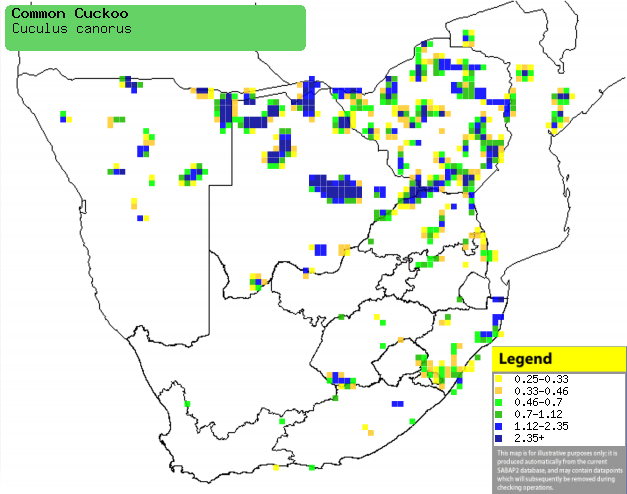|
Cuculus canorus (Common cuckoo ,
European cuckoo)
Europese koekoek [Afrikaans]; Mukuku (generic term for
cuckoos and coucals) [Kwangali]; Koekoek [Dutch]; Coucou gris [French];
Kuckuck [German]; Cuco-canoro [Portuguese]
Life
> Eukaryotes >
Opisthokonta
> Metazoa (animals) >
Bilateria >
Deuterostomia > Chordata >
Craniata > Vertebrata (vertebrates) > Gnathostomata (jawed
vertebrates) > Teleostomi (teleost fish) > Osteichthyes (bony fish) > Class:
Sarcopterygii (lobe-finned
fish) > Stegocephalia (terrestrial
vertebrates) > Tetrapoda
(four-legged vertebrates) > Reptiliomorpha > Amniota >
Reptilia (reptiles) >
Romeriida > Diapsida > Archosauromorpha > Archosauria >
Dinosauria
(dinosaurs) > Saurischia > Theropoda (bipedal predatory dinosaurs) >
Coelurosauria > Maniraptora > Aves
(birds) >
Order: Cuculiformes > Family: Cuculidae
Distribution and habitat
Breeds across Eurasia, from the Iberian Peninsula east to
Siberia and south to Japan and the Mediterranean; in the non-breeding season it
heads south it to sub-Saharan Africa. In southern Africa it is
locally common in central and northern Namibia (including the Caprivi Strip),
Botswana, Zimbabwe, central Mozambique and eastern South Africa. It generally
prefers woodlands, such as savanna, miombo (Brachystegia) woodland,
plantations and stands of trees around human settlements.
|
 |
|
Distribution of Common cuckoo in southern Africa,
based on statistical smoothing of the records from first SA Bird Atlas
Project (©
Animal Demography unit, University of
Cape Town; smoothing by Birgit Erni and Francesca Little). Colours range
from dark blue (most common) through to yellow (least common).
See here for the latest distribution
from the SABAP2. |
Movements and migrations
Arrives in southern Africa in the period from
October-November, departing in April.
Food
Eats mainly caterpillars, doing most of its foraging by
gleaning prey from leaves and branches. The following food items have been recorded
in its diet:
Threats
Not threatened, in fact it is widespread and common.
References
-
Hockey PAR, Dean WRJ and Ryan PG 2005. Roberts
- Birds of southern Africa, VIIth ed. The Trustees of the John Voelcker
Bird Book Fund, Cape Town.
|
